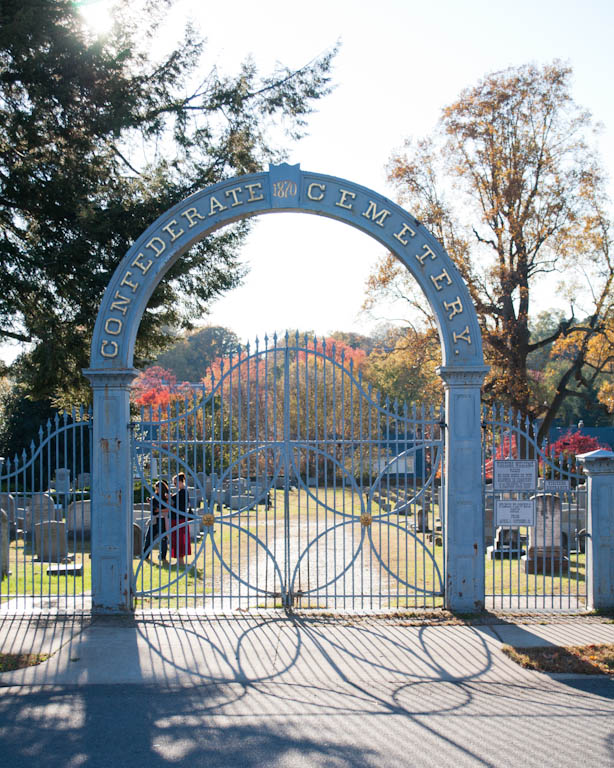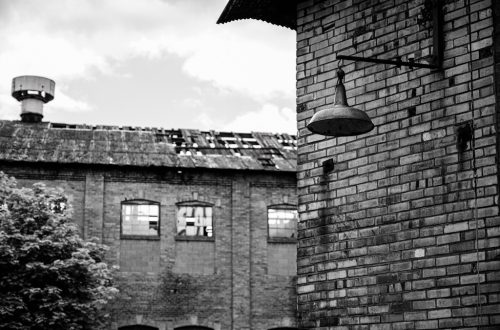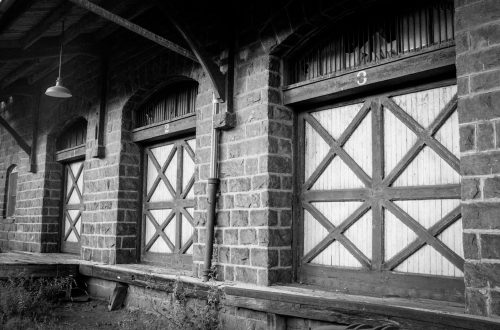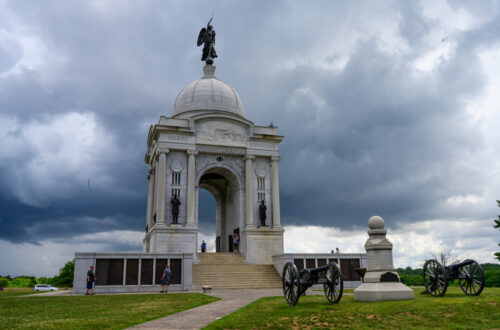Seven Score and Ten Years Ago . . .

Next week marks the 150th anniversary of the Battle of Gettysburg. By the end of June 1863 most of the Confederate Army of Northern Virginia was in Pennsylvania, and the battle was fought on July 1 – 3.
I have toured parts of Gettysburg National Military Park, but my most recent visit happened before I met Jonathan and he bought me a decent camera so I don’t have any pictures of the battlefield for this blog. Instead, as you see I re-posted the above picture that I took of the Fredericksburg Confederate Cemetery in Virginia. I originally intended to use this for the anniversaries of either the Battle of Fredericksburg or the Battle of Chancellorsville, but I missed both of these. There is a strong chance that I may post this photo once again in commemoration of the 150th anniveraries of the Battle of the Wilderness and the Battle of Spotsylvania Court House in 2014. After some reflection, I feel that my choice of photo here is appropriate for the following reasons:
1.) Not everybody who suffered or even died as a result of the Battle of Gettysburg is buried in Gettysburg, Pennsylvania. See this post from the blog of Gettysburg National Military Park on the whereabouts of Gettysburg’s Confederate dead.
2.) General Stonewall Jackson was mortally wounded by friendly fire in May 1863 after the Battle of Chancellorsville (which was fought outside Fredericksburg), and I learned in my eighth grade history class that his absence at Gettsyburg contributed to that battle’s final outcome. General Robert E. Lee decided to invade Pennsylvania after his success at Chancellorsville, so in June 1963 he began to move his army of Northern Virginia north from Fredericksburg.
3.) General Lee was married to Mary Custis, a great-grandaughter of Martha Custis Washington. The extended family had roots in Fredericksburg. (Kenmore Plantation, the home of Betsy Washington Lewis, is directly across the street from this cemetery.)
Apparently there are rival commemorations planned for the anniversary of Gettysburg. As this article explains, in addition to the National Park Service’s events, two private re-enactment groups formed to host their own, for-profit events at locations near the battlefield. I have no intention of going anywhere near Gettysburg during the anniversary of the battle because, in my experience, the place is busy enough during random weekends in October. This article supported my decision to stay away. I can’t wait to see online photos of it, though.
Growing up, I read a lot about the Civil War on my own, and my junior-senior high school also had a curriculum heavy on the subject, with a special focus on Gettsyburg. I personally find it difficult to write anything fresh about the horror and tragedies that were institutionalized slavery and the Civil War. Abraham Lincoln pretty much said it all. Therefore, I am going to share some of my favorite stories about Gettysburg:
1.) According to the first part of this article, the ghost of George Washington appeared during the battle to the Union army and helped lead them to victory . I am a bit skeptical. (Why didn’t the Father of our Country just appear to his great-grandson-in-law and tell him not to take up arms against the United States? It would have ended the war sooner.)
2.) Here is a good example of unethical behavior in photojournalism. Some photographers moved the body of a dead soldier across the battlefield in order to use the remains as a prop. There’s even a Devil’s Den ghost story attached to the incident.
3.) During the past year, the half-century old building that once housed Gettysburg’s Cyclorama was demolished. The concrete building, designed by modernist architect Richard Neutra, was built in the 1960’s in preparation of Gettysburg’s 100th anniversary. I remember going to this building to see the Cyclorama with my mom and some of my sisters when I was a kid. Unfortunately, it was built right on the battlefield, near the “high water mark” of the Confederacy during Pickett’s charge. One group of preservationists fought for years to remove it in order to restore the integrity of the battlefield, while another group fought for years to save it as an iconic piece of architecture. It was a shame that it was constructed on the battlefield to being with. (I see both sides of the controversy. However, I am not a huge fan of modernist architecture.)
4.) The Cyclorama building was one of the flagship projects of President Dwight Eisenhower’s “Mission 66” program that he launched in the 195o’s. Eisenhower, by the way, loved Gettysburg, PA so much that he spend the last years of his life there. Here’s something that I just learned, according to the Eisenhower Presidential Library and Museum: “With the exception of George Washington, Eisenhower is the only United States President with military service to reenter the Armed Forces after leaving the office of President.” (See, in the end, Gettysburg can always be connected to George Washington.)


